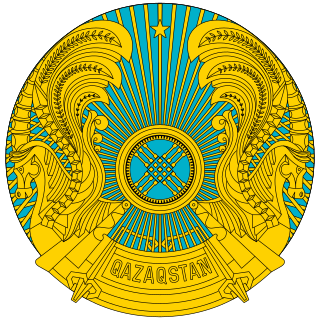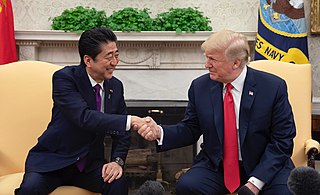
The foreign policy of the United States is its interactions with foreign nations and how it sets standards of interaction for its organizations, corporations and system citizens of the United States.

Foreign relations of Kazakhstan are primarily based on economic and political security. The Nazarbayev administration has tried to balance relations with Russia and the United States by sending petroleum and natural gas to its northern neighbor at artificially low prices while assisting the U.S. in the War on Terror. Kazakhstan is a member of the United Nations, Organization for Security and Co-operation in Europe, North Atlantic Cooperation Council, Commonwealth of Independent States, the Shanghai Cooperation Organisation, and NATO's Partnership for Peace program. Kazakhstan established a customs union with Russia and Belarus, transformed into the Eurasian Economical Community then in 2015 into the Eurasian Economic Union. President Nazarbayev has prioritized economic diplomacy into Kazakhstan's foreign policy.

The Mutual Security Act of 1951 launched a major American foreign aid program, 1951–61, of grants to numerous countries. It largely replaced the Marshall Plan. The main goal was to help poor countries develop and to contain the spread of communism. It was a signed on October 10, 1951 by President Harry S. Truman. Annual authorizations were about $7.5 billion, out of a GDP of $340bn in 1951, for military, economic, and technical foreign aid to American allies. The aid was aimed primarily at shoring up Western Europe, as the Cold War developed. In 1961 it was replaced by new foreign aid program. The Foreign Assistance Act of 1961, created the Agency for International Development (AID), which focused more on Latin America.

The Taiwan Relations Act is an act of the United States Congress. Since the recognition of the People's Republic of China, the Act has defined the officially substantial but non-diplomatic relations between the people of the United States and the people on Taiwan.
The United States Agency for International Development (USAID) is an independent agency of the United States federal government that is primarily responsible for administering civilian foreign aid and development assistance. With a budget of over $27 billion, USAID is one of the largest official aid agencies in the world, and accounts for more than half of all U.S. foreign assistance—the highest in the world in absolute dollar terms.

Post-occupation Japan is the period in Japanese history which started after the Allied occupation of Japan and ended in 1952. Japan has established itself as a global economic and political power. Even though after the war, Japan was led by an American written Constitution, they were still able to exert a stance that showed powerful influence. The Constitution was enacted on November 3, 1946 and became effective May 3, 1947. It included Article 9 clause, which restricted Japan from having a military force and engaging in war. Over the years, the meaning of article 9 has been interpreted differently, because the United States now encourages Japan to control its own security. The Liberal Democratic Party would like to see the Constitution and Article 9 amended.(LOC,2018)
Bilateralism is the conduct of political, economic, or cultural relations between two sovereign states. It is in contrast to unilateralism or multilateralism, which is activity by a single state or jointly by multiple states, respectively. When states recognize one another as sovereign states and agree to diplomatic relations, they create a bilateral relationship. States with bilateral ties will exchange diplomatic agents such as ambassadors to facilitate dialogues and cooperations.

The Mutual Defense Assistance Act was a United States Act of Congress signed by President Harry S. Truman on 6 October 1949. For US Foreign policy, it was the first U.S. military foreign aid legislation of the Cold War era, and initially to Europe. The Act followed Truman's signing of the Economic Cooperation Act, on April 3, 1948, which provided non-military, economic reconstruction and development aid to Europe.
A mutual legal assistance treaty (MLAT) is an agreement between two or more countries for the purpose of gathering and exchanging information in an effort to enforce public or criminal laws.

Japan–United States relations refers to international relations between Japan and the United States of America. Relations began in the late 18th and early 19th century, with the diplomatic but force-backed missions of U.S. ship captains James Glynn and Matthew C. Perry to the Tokugawa shogunate.

The Treaty of Mutual Cooperation and Security between the United States and Japan, also known in Japan as Anpo jōyaku (安保条約) or just Anpo (安保) for short, was first signed in 1951 at the San Francisco Presidio following the signing of the Treaty of San Francisco at the San Francisco War Memorial Opera House. Then, the Security Treaty was later amended further on January 1960 between the US and Japan in Washington.
In different administrative and organizational forms, the Food for Peace program of the United States has provided food assistance around the world for more than 50 years. Approximately 3 billion people in 150 countries have benefited directly from U.S. food assistance. The Office of Food for Peace within the United States Agency for International Development (USAID) is the U.S. Government's largest provider of overseas food assistance. The food assistance programming is funded primarily through the Food for Peace Act. The Office of Food for Peace also receives International Disaster Assistance Funds through the Foreign Assistance Act (FAA) that can be used in emergency settings.

The Sino-American Mutual Defense Treaty, formally Mutual Defense Treaty between the United States of America and the Republic of China, was a defense pact between the United States of America and the Republic of China effective from 1955–1979. It essentially prevented the People's Republic of China from taking over the island of Taiwan in this time. Some of its content was carried over to the Taiwan Relations Act of 1979.
The Mutual Defense Treaty between the Republic of the Philippines and the United States of America was signed on August 30, 1951, in Washington, D.C. between representatives of the Philippines and the United States. The overall accord contained eight articles and dictated that both nations would support each other if either the Philippines or the United States were to be attacked by an external party.

The Security Treaty Between the United States and Japan, was signed on 8 September 1951 in San Francisco, California between representatives of the United States and Japan.
The U.S. and Japan Mutual Defense Assistance Agreement was signed on March 8, 1954 in Tokyo between John Allison of the United States and Katsuo Okazaki of Japan. The accord contained eleven articles and seven amendments. The agreement dictated that both the United States and Japan support each other militarily. Specifically, it permitted the United States to station its troops on Japanese soil in order to maintain security in the region. Moreover, Japan was obligated to take responsibility in protecting itself and was permitted to rearm for defensive purposes only. Ultimately, the agreement was ratified on May 1, 1954.
The Balkan Pact of 1953, officially known as the Agreement of Friendship and Cooperation, was a treaty signed by Greece, Turkey, and SFR Yugoslavia on 28 February 1953. It was signed in Ankara. The treaty was to act as a dam against Soviet expansion in the Balkans. It provided for the eventual creation of a joint military staff for the three countries. At the time Turkey and Greece were members of the North Atlantic Treaty Organisation (NATO). Communist Yugoslavia, however, did not want to join NATO, which was made up of capitalist states. The Balkan Pact allowed Yugoslavia to associate itself with NATO indirectly.

Ethiopia–United States relations are bilateral relations between Ethiopia and the United States. Ethiopia is a strategic partner of the United States in the Global War on Terrorism. The United States is the largest donor to Ethiopia: in 2008 U.S. foreign aid to Ethiopia totaled US$969 million, in 2009 US$916, with 2010 estimated at US$513 and US$586 requested for 2011. U.S. development assistance to Ethiopia is focused on reducing famine vulnerability, hunger, and poverty and emphasizes economic, governance, and social sector policy reforms. Some military training funds, including training in such issues as the laws of war and observance of human rights, also are provided.
The Enhanced Defense Cooperation Agreement (EDCA) is an agreement between the United States and the Philippines intended to bolster the U.S.–Philippine alliance. The agreement allows the United States to rotate troops into the Philippines for extended stays and allows the U.S. to build and operate facilities on Philippine bases, for both American and Philippine forces. The US is not allowed to establish any permanent military bases. It also gives Philippine personnel access to American ships and planes.









